Psychology > EXAM > OLD BCBA Test Questions and Answer elaborations | 100% correct solutions (All)
OLD BCBA Test Questions and Answer elaborations | 100% correct solutions
Document Content and Description Below
OLD BCBA Test Questions: 1. Which of the following is NOT characteristic of the experimental analysis of behavior? a. It requires continuous observation b. It seldom provides readily applicable ... solutions to important problems c. It has its theoretical underpinnings in behaviorism d. It is a method for study in natural environments 2. Applied behavior analysis a. Ignores conceptual issues b. Was defined by Skinner (1953) c. Was defined by Baer, Wolf, and Risley (1968) d. Provides the foundation upon which the experimental analysis of behavior was developed 3. Applied behavior analysis a. Is antithetical to the experimental analysis of behavior b. Provides the foundation upon which the experimental analysis of behavior was developed c. Often applies the findings of the experimental analysis of behavior to laboratory issues d. Often applies the findings of the experimental analysis of behavior of social issues 4. “Applied” as a dimension of applied behavior analysis involves a. Using significant problems of participants to identify basic principles b. Resolving significant basic questions of principles of behavior c. Using basic principles on problems of significance to participants d. Using basic theoretical constructs on problems of significance to participants the 5. The behavioral dimension of applied behavior analysis focuses on a. Frequency of the behavioral measure b. Relevance and reliability of the experimental design c. (all of the others) d. Relevance and reliability of the behavioral measure 6. “Effective” as a dimension of applied behavior analysis involves treatment effects that are a. Clinically significant b. Permanent c. (all of the others) d. Statistically significant 7. “Technological” as a dimension of applied behavior analysis involves a. The use of technical, behavioral terminology to explain procedures b. The use of high technology in the analysis and interpretations of data c. Complete and precisely described procedures d. (none of the others) 8. Generality is evidenced by effective results of procedures implemented across a. (all of the others) b. Settings c. Individuals d. Procedural variations 9. A subject serving as his own control means a. There is a single intervention used in the experiment b. There is only one subject in the experiment c. That each intervention employed is measured repeatedly d. That each participant’s behavior is measured repeatedly 10. Applied behavior analysis a. Is antithetical to the experimental analysis of behavior b. Provides the foundation upon which the experimental analysis of behavior was developed c. Often applies the findings of the experimental analysis of behavior to laboratory issues d. Often applies the findings of the experimental analysis of behavior of social issues 11. Select the most parsimonious explanation. A 5-year-old tantrums in the candy aisle due to a. A personality disorder b. An emotional disturbance c. Cognitions resulting from poor parenting skills d. A history of reinforcement in the form of receiving candy for tantrum behavior 12. History as a threat to internal validity refers to a. Influence of multiple test taking b. Cyclic changes in the data c. Changes within the individual d. Events that occur during an experiment 13. Internal validity addresses which question a. Is the behavior change due only to the intervention b. Will the results carry over to other settings c. Are the procedures appropriate given the circumstances d. Will the results carry over to other individuals 14. Changing the teacher in the middle of a skills acquisition experiment threatens internal validity due to a. Multiple intervention interference b. Testing c. Maturation d. History 15. Multiple intervention (i.e., multiple treatment) interference is a threat to external validity due to a. Interactive affects b. Repeated testing c. Participant interactions d. Multiple treatments implemented simultaneously 16. refers to the degree to which a study’s results are generalizable to other subjects, settings, and/or behaviors. a. Internal validity b. External validity c. Experimental control d. Prediction 17. The results of a study show that praise was effective at increasing task completion, the intervention was only conducted during 8am Math Class, what threat to external validity should be considered? a. Generality across behavior-change agents b. Multiple-treatment interference c. Generality across time d. Diffusion of treatment 18. You conduct a study and the results indicate high level of variability in your baseline phase. What potential threat to validity is there? a. Generalized validity b. External validity c. Data-evaluation validity d. Construct validity 9. An experiment utilizes 7 different individuals to collect data what potential threat to data-evaluation validity exists? a. Unreliability of the measures b. Trends in the data c. Generality across settings d. Insufficient data 20. The goal of your research is to establish the efficacy of a newly developed intervention for increasing math skills. Which validity should be your priority? a. Internal b. External c. Data- Evaluation d. Construct 21. Functional assessment is MOST effective when... a. The behavior analyst can directly observe the behavior b. The behavior analyst has a lot of charts to review c. The behavior analyst speaks with the target individual’s caregiver d. None of the above 22. Operational definitions should meet these criteria... a. Objectivity b. Clarity c. Completeness d. All of the above 23. Objectivity refers to... a. Description of observable aspects of the behavior b. The definition can be easily understood by multiple observers c. Information on examples and non-examples of the target behavior are described d. All of the above 24. A key aspect of single case designs is... a. The behavior is observed once b. The behavior is observed on repeated occasions c. The behavior is never observed but charts are observed. d. None of the above 25. Validity refers to... a. The extent to which a measure assesses the construct of interest b. The extent to which a behavior can be recorded in the same way repeatedly c. The interobserver agreement value d. All of the above 26. Use frequency only when a. The duration of the response is an important dimension b. Observation length and opportunities to respond remain constant c. Observation length and opportunities to respond are variable d. The rate of the response remains constant 27. Whole-interval recording tends to a. Overestimate frequency b. Approximate frequency as interval size increases c. Be an appropriate measure when the length of time a behavior takes is unimportant d. Underestimate frequency 28. A woman with developmental disabilities is a slow walker when crossing the street, raising the fear that she might get hit by a car. Which would be an appropriate measure? a. Latency b. Partial-interval c. IRT d. Duration 29. A woman with developmental disabilities is slow to begin crossing when the street light changes, raising the fear that she might get hit by a car. Which would be an appropriate measure? a. IRT b. Latency c. Partial-interval d. Duration 30. An individual exhibits pseudo (fake) seizures of various durations. Which is the best measure? a. Partial interval b. Latency c. Duration per occurrence d. Frequency 31. When using inter-response time (IRT), start the timer a. When the behavior begins b. At the cessation of the stimulus that is to occasion the behavior c. At the presentation of the stimulus that is to occasion the behavior d. When the behavior stops 32. When using latency, stop the timer a. At the onset of the behavior b. At the presentation of the stimulus that is to terminate the behavior c. At the presentation of the stimulus that is to occasion the behavior d. At the onset of the behavior and start it at its offset 33. Using momentary time sampling procedure, it is necessary to observer a. Momentarily several times throughout the interval until the behavior is observed b. During the entire interval c. Very briefly at the end of the interval d. During the entire interval or until the behavior is observed 34. Which exemplifies a frequency measure? • The time between the onset and cessation of a response • The number of instances of self-injurious behavior during a class period • The number of intervals in which self-injurious behavior occurs in one hour • The number of minutes an individual spends on a task 35. An elementary school student tends to tease when lined up, but he occasionally teases at other times. Collect a. Whole-interval data only when lined up b. Whole-interval data throughout the day c. Frequency data throughout the day d. Frequency data only when lined up 36. A behavior analyst is assessing preference between six items by presenting them two at a time to a student. What preference assessment is most likely being used? a. Paired stimulus b. Single stimulus c. MSWO d. MSW 37. A behavior analyst is assessing preference between six items by presenting all six to a student at one time and measuring how long the student engages with each item. Which preference assessment is most likely being used? a. Paired stimulus b. Free operant c. MSWO d. Single stimulus 38. True or false. An item that was not selected during a paired stimulus preference assessment can never be a reinforcer? • True • False 39. A multiple schedule is when... a. Two schedules of reinforcement are effect for a response but only one is in effect at any time. b. Two schedules of reinforcement are in effect for a response and both are available simultaneously c. One schedule of reinforcement is in effect for a target response d. Three or more schedules of reinforcement are in effect for a response at the same time 40. True or false. A stimulus that is a reinforcer under fixed ratio (FR) 1 requirements will definitely be a reinforcer under FR 10 requirements? • True • False 41. A reinforcer assessment... a. Does not deliver a stimulus contingent on a target response to study future changes in the response b. Delivers a stimulus contingent on a target response to study future changes in the response c. Assesses time allocation when all stimuli are freely available d. Is not a concept taught in behavior analysis 42. Interviews are not the most effective way to evaluate preference because... a. There is sometimes poor correspondence between verbal report and actual choice making b. There is a low rate of false positive identification of preferred stimuli c. It is a complicated approach d. It is a slow approach that takes quite a bit of time and energy 43. What is a limitation of the free operant preference assessment approaches? a. You can identify a preference hierarchy b. You may conclude some stimuli are not preferred when they actually are c. There are no limitations d. It takes a long time to complete 44. Reinforcement for completing 6 math problems is one m&m when the candy icon is visible and 2 min on the ipad when the ipad icon is visible. This is a a. Concurrent schedule of reinforcement b. Multiple schedule of reinforcement c. Progressive schedule of reinforcement d. Multiple stimulus with replacement 45. At first a child shows no preference for earning M&Ms or skittles for completing 3 math problems. The requirements for accessing reinforcement (M&Ms or Skittles) increases to 6 then 10 problems. The child now shows a preference toward M&Ms. What schedule of reinforcement is described? a. Concurrent schedule of reinforcement b. Free operant c. Progressive schedule of reinforcement d. Multiple stimulus with replacement 46. Which characterizes the logic behind interobserver agreement? a. Two people observing is more likely to influence a behavior than if one is observing b. (all of the others) c. If two people say that something occurred, it is more likely that it did d. Interobserver agreement improves accuracy of data collection 47. Minimum acceptable interobserver agreement for publication is usually a. 95% b. 100% c. 70% d. 80% 48. Interobserver agreement can be influenced by a. Interval size b. Validity of the dependent measure c. Complexity d. (all of the others) 49. Which is the correct nonoccurrence (unscored interval) calculations of interobserver agreement? a. 78% b. 86% c. 75% d. 90% 50. To calculate interobserver agreement on duration measures, divide the a. Number of intervals in which both observers recorded an occurrence by the total number of intervals (x100) b. Time recorded by the observer who recorded the longest duration by the time recorded by the observer who recorded the shortest duration (x100) c. Duration of one observer by the sum of the duration of both observers (x100) d. Time recorded by the observer who recorded the shortest duration by the time recorded by the observer who recorded the longest duration (x100) 51. Which is the correct occurrence (scored interval) calculation of interobserver agreement? a. 14% b. 44% c. 33% d. 10% 52. A strategy for obtaining accurate interobserver agreement is that observers should a. Be naïve to the objectives of the study b. Overlap observations but not necessarily conduct them simultaneously c. Observe from a different vantage point d. (all of the others) 53. Which reflects the logic behind the need to report occurrence/nonoccurrence agreement data. “Their interval-by-interval agreement is high… a. And overall agreement is high too.” b. And occurrence/nonoccurrence agreement is high as well.” c. But because the behavior is so frequent, they don’t seem to observer carefully.” d. But think they may be comparing data sheets.” 54. To calculate NONoccurrence interobserver agreement, divide the a. Number of intervals in which both observers recorded an occurrence by the number of intervals in which at least one observer recorded an occurrence (x100) b. Number of intervals in which both observers recorded an occurrence by the total intervals (x100) c. Frequency of occurrences recorded by one observer by the frequency of occurrences recorded by the other observer (x100) d. Number of intervals in which both observers recorded no occurrence by the number of intervals in which at least one observer recorded no occurrence (x100) 55. Disagreements between observers a. Are attributable to individual differences and should be accepted b. Can be minimized by keeping them abreast of changes in experimental conditions c. Should be analyzed d. Can be averaged 56. The following are threats to the validity of a reversal design EXCEPT, a. Overlapping data points b. A decreasing trend during baseline for a behavior targeted for reduction c. Steady-state responding during baseline d. An increasing trend during baseline for a behavior targeted for reduction 57. Which of the following is an example of differential reinforcement of alternative behavior? a. A child engages in communication to access an item and the item is delivered. b. A child does not engage in the targeted problem behavior for 30 s and so the reinforcer is delivered. c. The reinforcer is delivered every 30 s regardless of the behavior. d. All of the above 58. Which of the following is an example of noncontingent reinforcement? a. A child engages in communication to access an item and the item is delivered. b. A child does not engage in the targeted problem behavior for 30 s and so the reinforcer is delivered. c. The reinforcer is delivered every 30 s regardless of the behavior. d. A child works for 45 sec and then requests access to a preferred item. 59. What design is being highlighted. To decrease automatically reinforced self injury, a behavior analyst evaluates the following conditions: baseline, response blocking, baseline, and response blocking. a. ABCBC b. ABAB c. ABA d. ABCDAD 60. What design is being described. To decrease self injury that occurs to escape from demands, a behavior analyst evaluates the following functional communication training package: baseline, FCT only, FCT with DRI, baseline, FCT with DRI. a. ABAB b. ABCAC c. ABCBC d. ABA 61. What design is being described. To decrease aggression that occurs to gain access to attention, a behavior analyst evaluates the following treatment program: fixed time reinforcement, baseline, and fixed time reinforcement. a. BAB b. ABAB c. ABC d. AB 62. What design is being described. To decrease aggression that occurs to gain access to attention, a behavior analyst evaluates the following treatment program: baseline, FCT, FCT with DRI, FCT, baseline, FCT with DRI. a. ABCBAC b. ABA c. ABCAC d. AB 63. Which of the following is an example of differential reinforcement of incompatible behavior? a. A reinforcer is delivered when a child does not engage in a target behavior for 30 seconds. b. A child who pulls their hair when watching television is given an M&M as reinforcement for playing with a fidget toy with her hands. c. A child communicates for attention and their parent immediately plays with them. d. All of the above. 64. Which of the following provides the most convincing demonstration of experimental control? a. Chart 1 b. Chart 2 c. Chart 3 d. Chart 4 65. What next? a. Continue to intervene on the first behavior b. Continue to intervene on the first two behaviors c. Begin to intervene on another behavior d. Continue baseline conditions 66. With multiple baseline design, a functional relation requires a. A return to baseline b. A replication of behavior change across at least three behaviors, interventions, or settings c. (all of the others) d. A change in behavior with onset of the intervention 67. When using multiple baseline design, a. Achieve stable responding for all target behaviors before intervening, if possible b. Use one intervention across three behaviors that are part of the same response class c. Achieve stable responding for nontarget behaviors before intervening, if possible d. Use three interventions across the three behaviors that are not part of the same response class 68. Which of the following criterion would most likely indicate experimental control in a changing criterion design? a. 10, 12, 16, 24, 32, 42 b. 10, 14, 16, 20, 22, 26 c. 10, 12, 14, 16, 18, 20 d. 10, 14, 16, 24, 22, 28 69. With a changing criterion design, demonstration of a functional relation can be enhanced by a. Instituting same-size criterion changes b. Instituting a criterion contrary to the general trend c. Changing the criterion before stability is achieved d. (all of the others) 70. You have a child who has three behavior problems in the classroom. You should use a multiple baseline across a. Settings b. Children c. Subjects d. Behaviors 71. What next ? a. Continue to intervene on the third behavior b. Begin to intervene on the first two behaviors c. Continue to intervene on the first behavior d. Begin to intervene on the third behavior 72. What next ? a. Continue to intervene on the third behavior b. Begin to intervene on the first two behaviors c. Continue to intervene on the first behavior d. Begin to intervene on the third behavior 73. Experimental control is absent because? a. Conditions are not staggered b. There is not return to baseline c. (Experimental control IS demonstrated) d. Behavior changes do not correspond to condition changes 74. Experimental control is absent because? (Graph Above) a. There is too much overlap in second and third graphs b. (experimental control IS demonstrated) c. There is no return to baseline d. Conditions are not staggered 75. Experimental control is absent because? a. Conditions are not staggered b. Behavior changes do not correspond to condition changes c. (experimental control IS demonstrated) d. There is too much overlap in second and third graphs 76. Which type of graph or chart would be best for recording the percent of intervals off-task? a. Line graph b. Bar graph c. Cumulative graph d. Standard celeration chart 77. Which type of graph or chart shows the proportional or relative changes in behavior? a. Line graph b. Bar graph c. Cumulative graph d. Standard celeration chart 78. If asked, “How variable are your data?” you are being asked: a. What is the change in the mean value of your data set? b. How evenly or irregularly is the change taking place? c. Is the pattern of the data rising or falling over time? d. What is the average standard deviation of your data? 79. If asked, “What is the change in levelof your data?” you are being asked: a. What is the change in the mean value of your data set? b. How evenly or irregularly is the change taking place? c. Is the pattern of the data rising or falling over time? d. What is the average standard deviation of your data? 80. Which type of graph or chart would be best for recording each day a homework assignment was handed in on time? a. Line graph b. Bar graph c. Cumulative graph d. Standard celebration chart 81. The standard graphing format does NOT include: a. Phase labels b. A label for the graph c. Labels for the units of measurement on both the ordinate and abscissa d. Data points connected across phases 82. A cumulative record showing a trend line going down a. Indicates a decreasing rate b. Indicates a decreasing trend c. Indicates no responding d. Never occurs 83. Which is correctly labeled? a. A b. B c. C d. D 84. Which best describes the graph? a. High, stable responding followed by decreasing trend in the second phase b. Low, variable responding followed by low, stable responding in the same phase c. High, stable responding followed by the low, stable responding in the same phase d. Low, variable responding followed by low, variable responding in the same phase 85. With which baseline data path would it be most appropriate to being an intervention for tantrum behavior? a. Chart A b. Chart B c. Chart C d. Chart D 86. Which of these designs establishes experimental control? a. Multiple baseline b. Multiple probe c. Reversal design d. All the above 87. The alternating treatments design improves upon which aspect of the reversal design? a. Sequence effects b. It is the “best” single case design c. Research shows it is less preferable to implement brief returns to baseline d. All the above 88. Which of the following represents a combined experimental design? a. Reversal plus multiple baseline b. Alternating treatments plus reversal design c. Group Designs d. A and B only 89. One challenge with implementing an alternating treatments design is… a. It is more time consuming than a reversal design b. It may be difficult for the individual to discriminate between conditions c. It is too easy for the individual to discriminate between conditions d. None of the above 90. The graph below represents which type of alternating treatment design? a. Alternating treatments with a no-treatment control condition b. Alternating treatments without a no-treatment control condition c. Alternating treatments with a baseline and best treatment condition d. None of the above 91. The graph below represents which type of alternating treatment design… a. Alternating treatments with a baseline b. Alternating treatments without a no-treatment control condition c. Alternating treatments with a baseline and best treatment condition d. None of the above 07/29/2019 07/29/2019 [Show More]
Last updated: 1 year ago
Preview 1 out of 35 pages
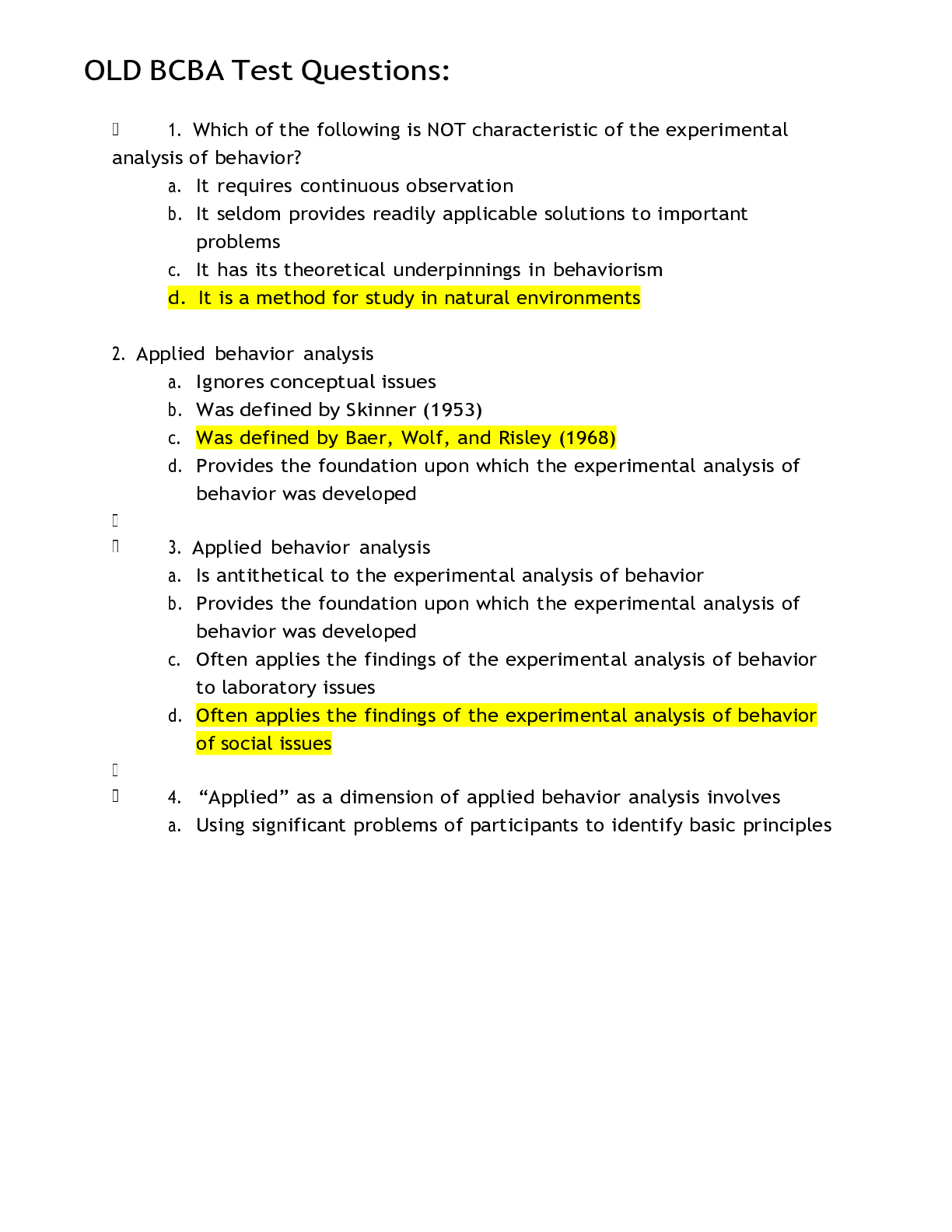
Reviews( 0 )
Recommended For You
Law> EXAM > WGU C181: Comprehensive Exam Guide US CONSTITUTION AND GOVERNMENT with 100% Correct Solutions (All)

WGU C181: Comprehensive Exam Guide US CONSTITUTION AND GOVERNMENT with 100% Correct Solutions
Democratic socialism *** A socialist form of government that guarantees civil liberties such as freedom of speech and religion. Citizens determine the extent of government activity through free elec...
By MollyBanks , Uploaded: Jul 26, 2023
$11
*NURSING> EXAM > 2023-2024 ATI RETAKE TEST QUESTIONS AND ANSWERS (All)
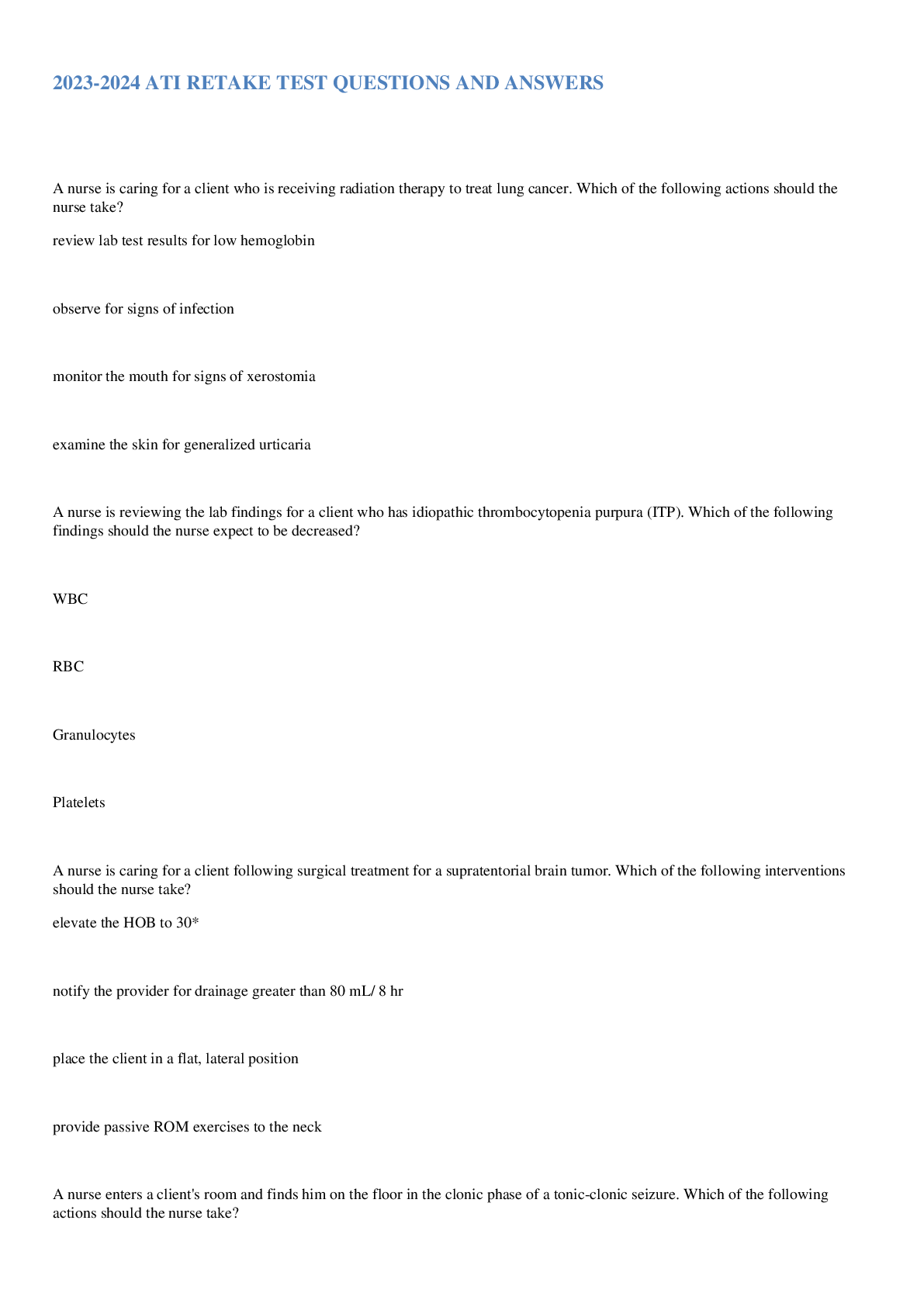
2023-2024 ATI RETAKE TEST QUESTIONS AND ANSWERS
2023-2024 ATI RETAKE TEST QUESTIONS AND ANSWERS 1. A nurse is caring for a client who is receiving radiation therapy to treat lung cancer. Which of the following actions should the nurse take? a...
By tutorcwakuthii , Uploaded: Aug 18, 2023
$11.5
*NURSING> EXAM > NR 503 Week 4 Midterm Review Guide (Chapter 5– 6) | Student Consult Questions with Rationale | 100% Correct Solutions (All)

NR 503 Week 4 Midterm Review Guide (Chapter 5– 6) | Student Consult Questions with Rationale | 100% Correct Solutions
Which of the following is a condition which may occur during the incubation period? • Onset of clinical illness • Receipt of infection • Signs and symptoms of disease • Transmission of infection...
By A+ Solutions , Uploaded: Feb 01, 2022
$23
*NURSING> EXAM > NR 503 Week 4 Midterm Review Guide (Chapter 2 – 4) | Student Consult Questions with Rationale | 100% Correct Solutions (All)

NR 503 Week 4 Midterm Review Guide (Chapter 2 – 4) | Student Consult Questions with Rationale | 100% Correct Solutions
Question: Which of the following is a condition which may occur during the incubation period? Question: Chicken pox is a highly communicable disease. It may … transmitted by direct contact with a per...
By A+ Solutions , Uploaded: Feb 01, 2022
$15.5
*NURSING> EXAM > AHIP FINAL EXAM TEST QUESTIONS AND VERIFIED ANSWERS( 2023-2024 (All)
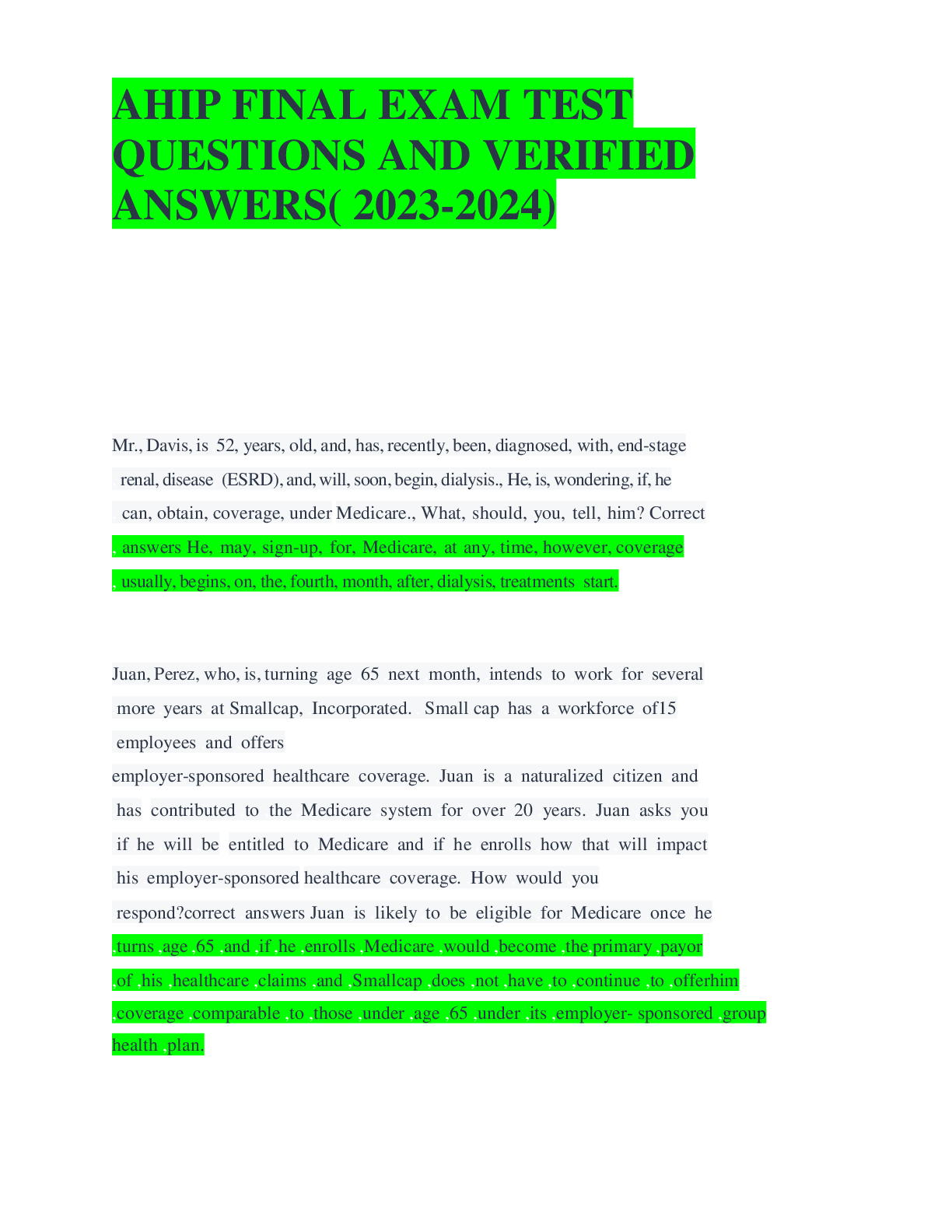
AHIP FINAL EXAM TEST QUESTIONS AND VERIFIED ANSWERS( 2023-2024
AHIP FINAL EXAM TEST QUESTIONS AND VERIFIED ANSWERS( 2023-2024
By Nursejames , Uploaded: Aug 05, 2023
$9.5
*NURSING> EXAM > AMLS Pretest _Advanced Medical Life Support Pretest questions and answers (all correct) (All)
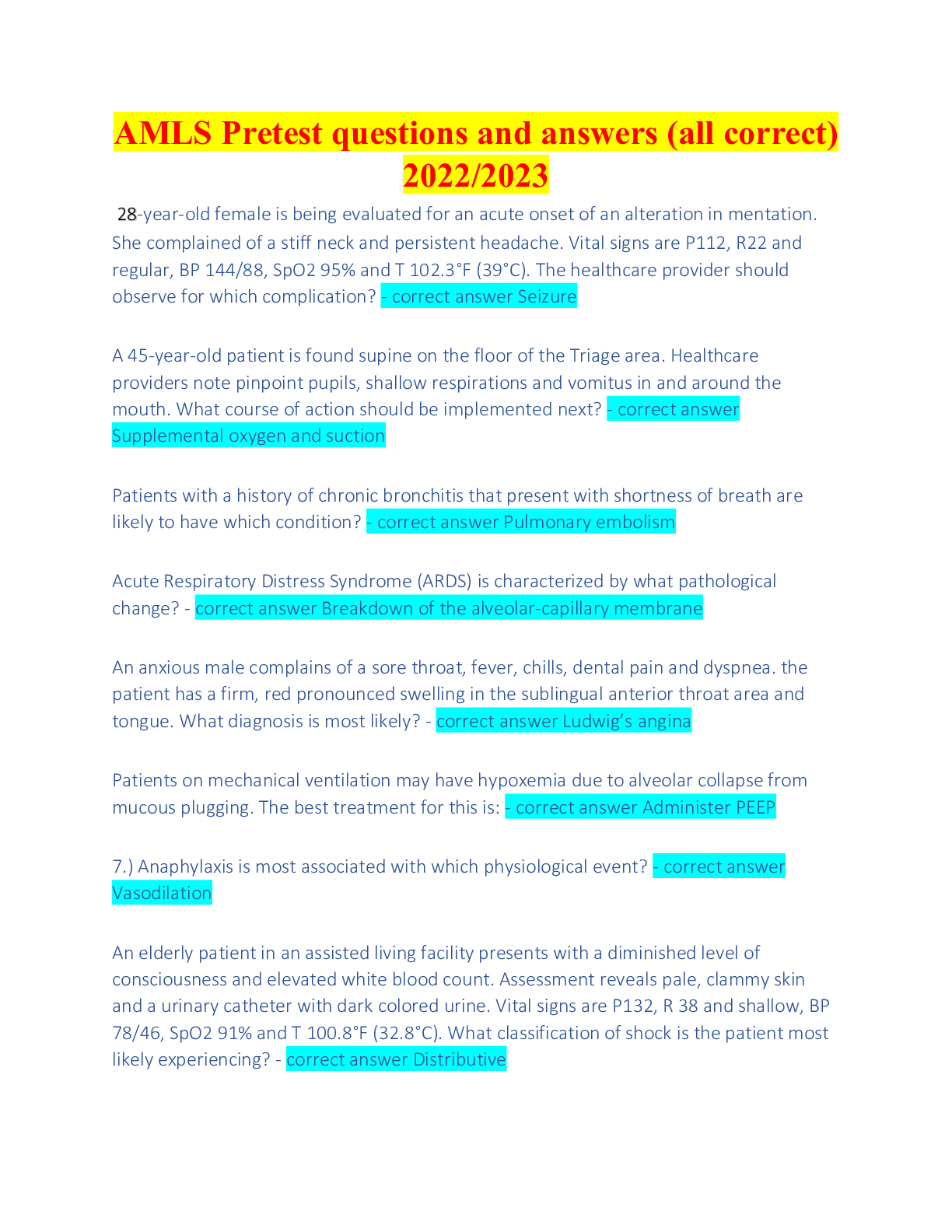
AMLS Pretest _Advanced Medical Life Support Pretest questions and answers (all correct)
Exam (elaborations) AMLS Pretest questions and answers (all correct) 2021/2022. AMLS (Advanced Medical Life Support) AMLS Pretest questions and answers (all correct) 2021/2022.
By Jackie09 , Uploaded: Sep 07, 2022
$9.5
*NURSING> EXAM > NURS 65211 FINAL EXAM. Walden University _LATEST QUESTIONS AND ANSWERS. GRADE A-100%. (All)
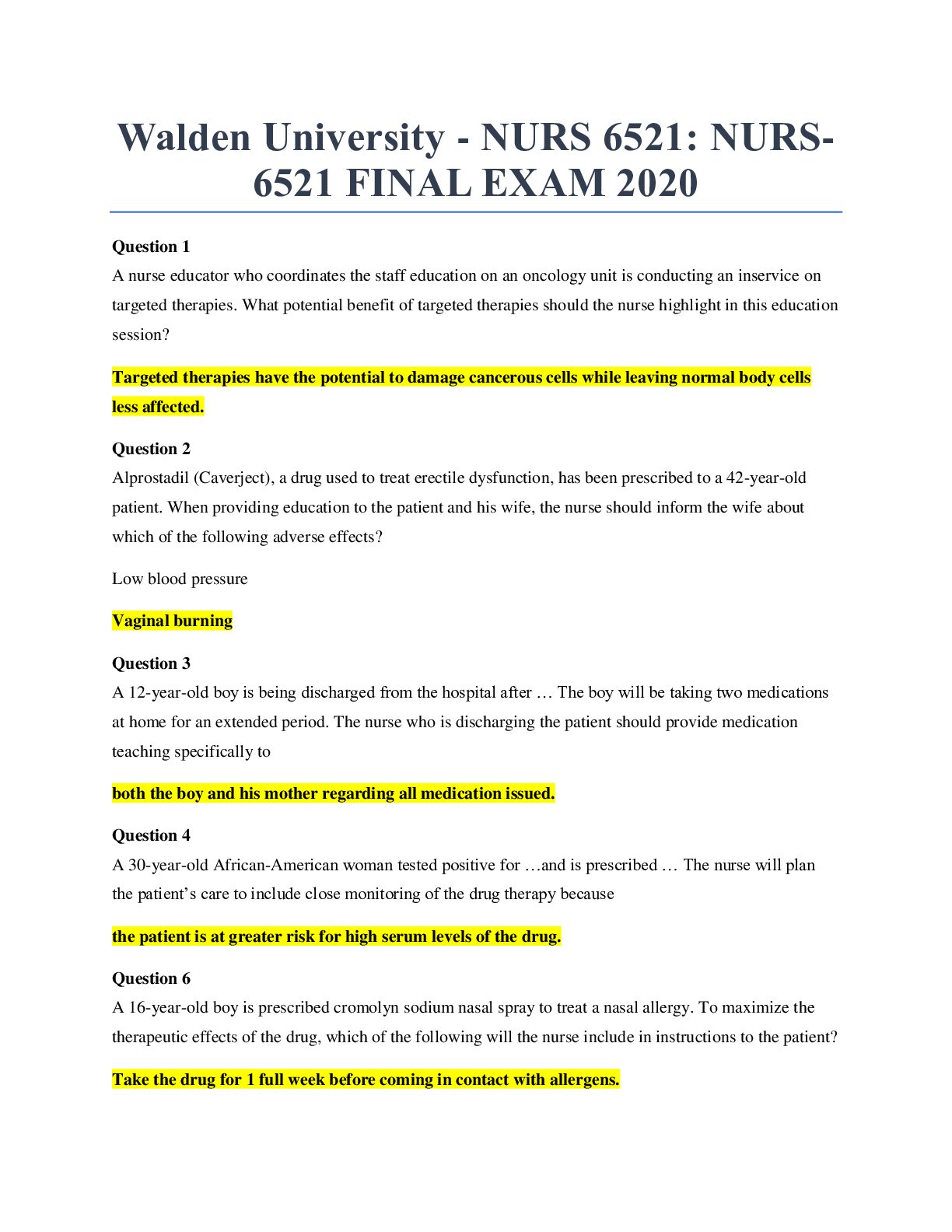
NURS 65211 FINAL EXAM. Walden University _LATEST QUESTIONS AND ANSWERS. GRADE A-100%.
NURS 65211 FINAL EXAM. Walden University _ Question 1 A nurse educator who coordinates the staff education on an oncology unit is conducting an inservice on targeted therapies. What potential benefi...
By Kirsch , Uploaded: Jun 01, 2020
$12.5
*NURSING> EXAM > ATI DOSAGE CALCULATIONS – 100% CORRECT SOLUTIONS GUIDE (All)
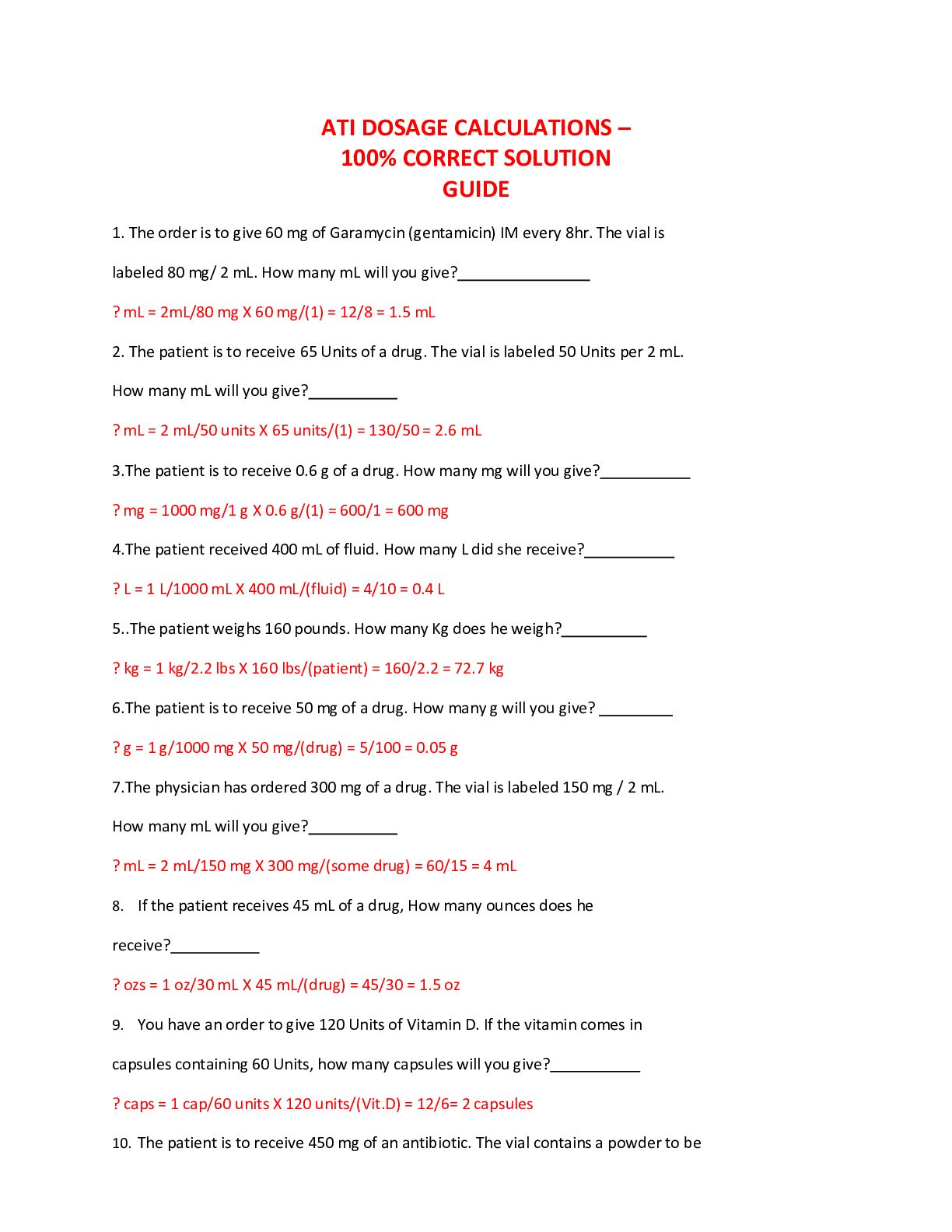
ATI DOSAGE CALCULATIONS – 100% CORRECT SOLUTIONS GUIDE
ATI DOSAGE CALCULATIONS – 100% CORRECT SOLUTIONS GUIDE 1. The order is to give 60 mg of Garamycin (gentamicin) IM every 8hr. The vial is labeled 80 mg/ 2 mL. How many mL will you give? ? mL = 2mL/...
By PHISHER , Uploaded: Dec 30, 2021
$16.5
Health Care> EXAM > AHIP Final Exam Test Questions and Answers (2022/2023) (Verified Answers) (All)
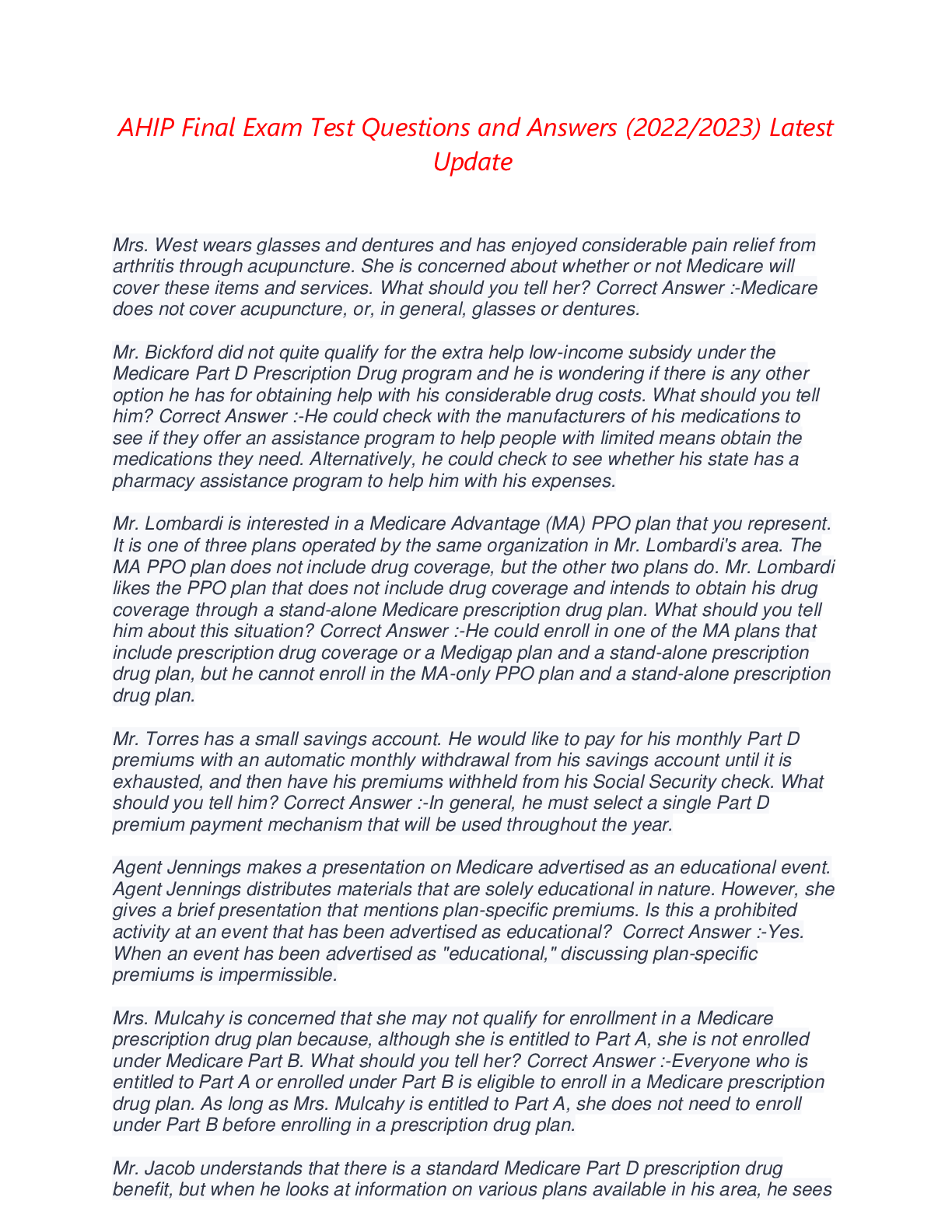
AHIP Final Exam Test Questions and Answers (2022/2023) (Verified Answers)
AHIP Final Exam Test Questions and Answers (2022/2023) Latest Update Mrs. West wears glasses and dentures and has enjoyed considerable pain relief from arthritis through acupuncture. She is concer...
By Topstudies , Uploaded: Aug 21, 2022
$10.5
Health Care> EXAM > AHIP Final Exam Test Questions and Answers (2022-2023)! Rated A+ Ans (All)
! Rated A+ Ans.png)
AHIP Final Exam Test Questions and Answers (2022-2023)! Rated A+ Ans
AHIP Final Exam Test Questions and Answers (2022-2023)! Rated A+ Ans
By ACADEMICTUTORIAL , Uploaded: Feb 12, 2023
$6
Document information
Connected school, study & course
About the document
Uploaded On
Jun 20, 2022
Number of pages
35
Written in
Additional information
This document has been written for:
Uploaded
Jun 20, 2022
Downloads
0
Views
58






